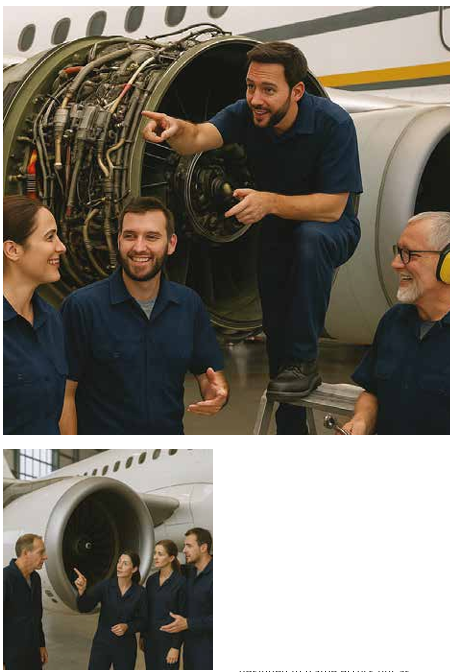
Psychological Safety Among Aircraft Maintenance Technicians:
A Catalyst for Safety and Performance
In aviation maintenance, psychological safety is a non-negotiable factor in preventing human error and ensuring airworthiness. It fosters open communication, rapid learning, and team accountability under high-stress conditions. Far from being a “soft” concept, it is a practical necessity that enables technicians to report near-misses, seek clarity, and challenge outdated practices without fear ultimately strengthening safety culture and organizational resilience.
In aviation maintenance, where precision and collaboration determine systemic reliability, psychological safety, which is defined by Amy Edmondson (2019) as a teams shared belief in interpersonal risk-taking without negative consequences”, is a non-negotiable component of safety culture. For technicians working under time pressure on safety-critical systems, it enables transparent reporting of errors, ambiguous protocols, or equipment anomalies without fear of blame.
Operational Necessity, Not Luxury Aircraft maintenance demands flawless teamwork, knowledge sharing, and rapid adaptation. Psychological safety is not a soft” ideal but a practical requirement. It allows technicians to question procedures, admit knowledge gaps, or report near-miss actions critical to preventing latent errors. Without this safety, teams risk silence, suppressed concerns, and unreported deviations that compound into catastrophic failures.
Critical Outcomes of Psychological Safety
Proactive Risk Mitigation: Blame-free reporting cultures significantly increase disclosures of near-misses or procedural lapses. This encourages technicians to report potential issues without fear of reprisal. This early reporting is crucial, enabling swift corrective actions. For example, a technician noting a torque wrench calibration irregularity can immediately trigger fleet-wide inspections, thereby averting potential disasters before they occur.
Accelerated Competency Development: Junior technicians operating within psychologically safe teams are more inclined to ask questions, actively seek feedback on their work, and even respectfully challenge outdated practices.
This fosters a continuous learning environment. This is particularly vital in the rapidly evolving aviation maintenance industry, where effective mentorship and the swift adoption of new technologies (e.g., AI diagnostics) are key determinants of competency.
Collective Accountability: Complex and intricate tasks such as engine overhauls necessitate seamless coordination and clear communication among team members. Psychological safety ensures that technicians feel empowered to vocalize any uncertainties they may have (e.g., “Was the hydraulic line fully secured?”). This open dialogue acts as a crucial safety net. By encouraging these vital questions, psychological safety plays a key role in preventing oversights that could ultimately compromise the airworthiness of the aircraft.
Resilience Against Human Factors: High-stress operational environments within aircraft maintenance can significantly exacerbate common human factors such as fatigue and decision fatigue. Teams that cultivate a strong sense of psychological safety demonstrate notably lower burnout rates among their members and report higher levels of job satisfaction. This improved well-being directly translates to a reduced likelihood of human error in critical maintenance tasks.

Leadership’s Role in Sustaining Safety
Supervisors and senior engineers must actively model vulnerability, this includes publicly discussing their own errors to normalize learning from mistakes. Furthermore, they should consistently reward transparency when errors or near-misses are reported and respond to mistakes with genuine curiosity (e.g., proactively asking, “What systemic gaps might have caused this to occur?”). This approach fosters an environment where learning and improvement are prioritized over blame.
Punitive reactions to minor lapses, such as a missed inspection step, can severely erode trust within the team, making individuals hesitant to report future issues. Conversely, a coaching approach in response to errors effectively reinforces learning and helps prevent recurrence. Organizations must ensure their policies are fully aligned with “just culture” principles, which are crucial for effectively distinguishing between reckless behavior, which requires disciplinary action, and unintentional errors, which should be addressed through learning and system improvements. Finally, training programs should be carefully designed to frame errors not as individual failures but as valuable opportunities for organizational improvement and the strengthening of safety protocols.
Conclusion: In aviation maintenance, psychological safety is not optional its the bedrock of operational integrity. It transforms human fallibility into a proactive safety net, ensuring technicians prioritize airworthiness over silence. For an industry where 80% of incidents trace to human factors, cultivating such environments is a strategic imperative, safeguarding both lives and organizational credibility.